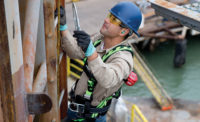It’s time we tried a different approach based on: 1) Assessing the human factors involved in using hearing protection on the job; and 2) Utilizing new materials and processes to develop products that more adequately meet these needs.
These human factors can best be described as the four Cs of hearing protection: Caring, Comfort, Convenience, and Communication. Let’s look at these in more detail.
Caring
Many people don’t realize that the impact of hazardous noise is cumulative and that even brief periods without protection, if repeated, can lead to significant hearing loss. Many also fail to realize that hearing loss is permanent.Compounding this problem is the fact that we live in a culture that increasingly accepts noise as fun, recreational, or just another aspect of modern life. We are conditioned by our everyday environment not to take noise seriously. We all know of workers who remove their hearing protection at the end of their shift, then crank their car stereos up for the ride home, blissfully unaware that this sound can be as dangerous as a jack-hammer.
Thus, a big part of any successful hearing conservation initiative is getting people to take noise seriously, both on and off the job. It takes a steady effort over time to change worker behavior, and safety officers would do well to take advantage of the educational materials offered by many manufacturers of hearing protection products.
Comfort
Earplugs are the only type of PPE that is actually inserted and worn inside the body. Thus, workers’ experience with these products is very intimate and studies have clearly shown that comfort is a prime driver in how diligently people will wear hearing protection.It’s important, then, to offer workers a number of choices in hearing protection products. Softer, more comfortable polyurethane foam earplugs have rapidly replaced many of the old PVC barrel-type earplugs. New contoured designs also tend to fit better than cylinder-shaped plugs. Low-pressure foam earplugs in smaller diameters work well for female workers and others with smaller ear canals. In reusable plugs, new materials such as TPE (thermoplastic elastomer) actually soften with body heat and allow the plug to conform to the shape of the wearer’s ear canal.
Many manufacturers recommend that safety professionals run regular trials of hearing protection products to let workers decide what works best on the job. Using a small “test group†of employees whose opinions you trust is a good way to assess what might be best for your workplace.
Convenience
Convenience boils down to two factors: availability and ease of use.Availability is easy to address. Just make sure hearing protection devices are available wherever they are needed. For constant noise hazard areas, earplug dispensers provide instant access. For people who move through a variety of areas, reusable earplugs are available with carrying cases, or with integral cords so they can be worn around the neck and be available whenever needed.
Ease of use is another important human factor that should not be overlooked. Rolling a traditional cylinder earplug down, inserting it and then waiting for it to fully expand in the ear canal takes time.
New no-roll foam earplugs provide simple, easy and immediate protection whenever it’s needed. These plugs are designed with a stiff, central core to facilitate insertion, and there is no waiting for foam to expand before protection is effected. Many reusable plugs offer the same convenience, and banded plugs provide a handy solution for people on the move.
Communication
It is not rocket science to suggest that danger is increased when an equipment operator cannot hear someone yell, “Stop!â€, or when workers in any situation cannot hear critical instructions. Plus, human beings are social by nature. They want to communicate with each other on the job, and a common complaint against hearing devices is that workers cannot hear when they are wearing them.One solution to this problem is to facilitate communication through electronics. There are a number of products available — typically earmuffs — that provide outstanding communication capabilities while blocking harmful ambient noise. Newer products even connect earmuffs to cell phones and radios. These products come with a significant price tag, however, and do not provide a practical solution to the average workplace.
A better solution is offered by new material and process technologies that allow earplugs and earmuffs to block sound uniformly across different octave bands. Products offering this feature, called uniform attenuation, can effectively block harmful noise while allowing human voice frequencies to pass through more easily.
